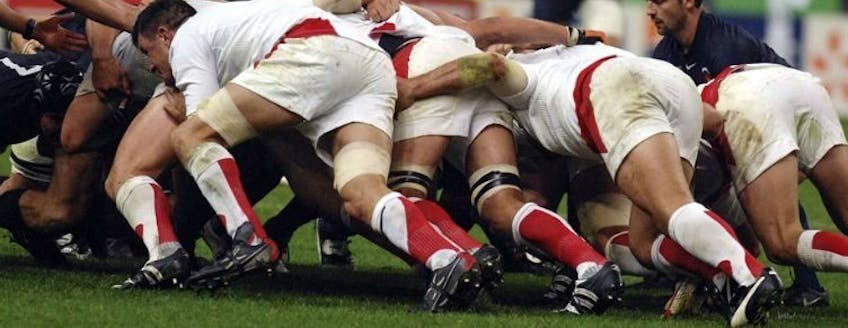Rugby is one of the most popular team sports in the world due to the high intensity and fast-moving nature of the game.
Since Rugby Union turned professional in 1995, the game has become even more physically demanding, as players have become fitter, stronger, quicker and more powerful. As these four elements continue to improve, the risk of sustaining an injury also increases.
When do rugby injuries occur?
According to a report by the RFU, there are currently around 17 injuries per 1000 hours of playing, which is nearly three times higher than the injury rates of football.
More rugby injuries occur during matches (57%) than in training, they also occur more often in the second half of a game. During matches, approximately half of all injuries occur while a player is tackling or being tackled. In training, endurance running and contact exercises are the biggest risk factors.
In addition, the use of artificial playing surfaces in across all levels in rugby is expected to increase in the future. However, it is unclear whether there will be any significant increase in the risk of injury as a result, other than the increase in the number of skin abrasions.
Which Rugby Players Suffer the Most Injuries?
In terms of injuries, hookers and flankers are the most at risk. Moreover, because of their greater involvement in physical collisions and tackles, forwards are injured more regularly than backs. In the back row, it is wings, fullbacks and centres that bear the highest risk of injury.
When it comes to the scrum, locks have the highest risk of sustaining cauliflower ear and facial cuts. Whereas in rucks, the most common injuries are to fingers and thumbs, as well as scrapes and cuts from boots.
What are the most common rugby injuries?
The top 5 most common rugby match injuries are listed below, along with a breakdown of why they occur, and more importantly, how you can prevent them.
1. Hamstring Injury
What is it?
A hamstring injury is when the various muscle fibres that make up the hamstring tear (bicep femoris, semitendinosus and semimembranosus). There are roughly 2.5 hamstring injuries for every 1000 hours of playing time.
Why does it occur?
There are a range of factors that can lead to a hamstring injury; these include:
How can I help prevent it?
Thankfully there are a range of ways that you can help to prevent hamstring injuries. These include improving your overall strength and conditioning, working to improve your running technique, and introducing effective recovery techniques such as ice baths and foam rolling.
2. Ankle lateral ligament injury (sprained ankle)
What is it?
An ankle lateral ligament injury (sprained ankle) is when your ankle ligaments are overstretched, which results in soft tissue damage. The capsule that surrounds the ankle joint can also be damaged, causing bleeding within the tissues leading to a swollen ankle.
Injuries can vary in their severity, from mild sprains through to severe ligament ruptures, and even broken bones. There are roughly 2.9 ankle lateral ligament injuries for every 1000 hours of playing time.
Why does it occur?
Ankle sprains can occur by simply rolling your ankle or some unstable ground. Some examples include awkwardly planting your foot when running, landing unevenly from a jump or stepping onto an irregular surface.
How can I help prevent it?
Proprioception training is highly effective at helping to prevent ankle ligament injuries, as these exercises are designed to help players catch their balance when doing strenuous physical activities. Incorporating wobble boards and ankle braces can also help to improve the overall strength, stability and reflex of the ankle joint. You can also tape and brace your ankles during matches and training as this will help to reinforce the joint.
3. Medial collateral ligament (MCL) injury
What is it?
The MCL is a ligament found in your knee that works in unison with other ligaments to give you stability when walking and running. An MCL injury is when the fibres that make up this ligament are torn or completely ruptured. There are roughly 3.7 medial collateral ligament injuries for every 1000 hours of playing time.
Why does it occur?
An MCL injury is more likely to occur during sudden changes of direction or when the force of a tackle places excessive strain on the ligament causing a tear. This puts players who play in a back position at a higher risk of MCL injury due to their increased likelihood of being tackled and the need for fast changes of directions.
How can I help prevent it?
To reduce the risk of an MCL injury, you should use effective conditioning training to improve the strength of your knee, as well as utilising speed work to improve the resilience of your knee to sudden changes of direction.
4. Thigh haematoma
What is it?
A thigh haematoma is basically an extremely severe bruise as a result of damage to the blood vessels, which leads to blood leaking around the tissue resulting in the formation of a large clot. There are roughly 4.2 thigh haematoma injuries for every 1000 hours of playing time.
Why does it occur?
A haematoma occurs when there is a direct blow to the thigh area as a result of physical contact and impact. Given that rugby is a high contact sport, these types of injuries are part and parcel of the game.
How can I help to prevent it?
Unfortunately, in order to prevent this sort of injury, you would have to change what it is that makes rugby such a fantastic sport. Instead of focusing on prevention, it is better to focus on the introduction of a robust recovery plan as soon as possible after the injury occurs. Introducing RICE (rest, ice, compression and elevation) principles can help to significantly reduce recovery time and get you back to match fitness much sooner.
5. Concussion
What is it?
Concussions are traumatic head injuries that occur from both mild and severe blows to the head. There are roughly 10.5 concussion injuries for every 1000 hours of playing time, which is over 12% of all match injuries.
Why does it occur?
It is simply caused by the contact nature of rugby. Unlike other injuries, risk of concussion is the same for both the ball carrier and the tackler.
How can I help to prevent it?
In the same way that it is difficult to prevent thigh haematoma injuries, it is even more difficult to prevent concussions without changing the very nature of rugby. However, the RFU are working extremely hard to standardise the process for suspected head injuries. Moreover, they are also working to improve concussion awareness amongst players, coaches, referees and medical staff.
As a result, from 2011-12 onwards, a graduated return to play protocol has been introduced, which requires a minimum return to play time of 6 days for all concussion injuries, dependent on a player’s individualised recovery.





















